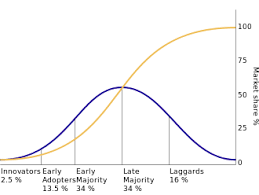We are coming up to the time of year when pundits write about trends and innovations in market research for the coming year. Why are such predictions often too optimistic about the speed with which such innovations are adopted?
I recently had the pleasure of teaching students taking a course on “Disruptive innovation” as part of an MA in Social Innovation. One of the core topics covered the diffusion of innovation, a theory developed by Everett M. Rogers through social research, but which also underpins many (if not all) product forecasting models used in market research. As with many such theories, market researchers don’t always apply the theory to our industry in the same way we think about client’s businesses.
Rogers theory focuses on the importance of new ideas diffusing through interpersonal communication. He argues that certain factors are very important in determining the speed with which a new idea will spread in awareness and ultimately in adoption. It’s worth considering the factors he identified.
Does the new idea have a relative advantage over existing ones? An advantage can be an economic benefit, improved performance, greater convenience or even emotional benefits such as social prestige.
Is the new idea compatible with existing beliefs and past experiences? If the idea doesn’t meet the needs of the industry it won’t be adopted. If the idea clashes with existing cultural and social norms it will be rejected.
Is the new idea simpler or more complex than existing ideas? If an idea is difficult to understand and use, then it may be difficult to get traction, whereas if it simple to understand and use it is much more likely to be used.
Is the new idea “trialable”? How easy is it to access the new idea and “try it out”? As with new product launches, customers have to be aware of any new idea (and why it is relevant to them) and also be able to access in a time, place and manner convenient to them.
Rogers’ final factor is observability. Are the results (and benefits) of any new idea visible to others, making it easy for them to have exposure to any benefits that the new idea provides?
Looking at market research innovations through this lens helps clarify why many take much longer to be adopted than predicted. It may also provide a reality check on more recent innovations in the industry.
Let’s take the examples of artificial intelligence (AI), automation and chatbots, all predicted to take over the market research world in 2019. What are their relative advantages over other approaches? Is using them compatible with existing industry practices? Are they simple to understand? Are they easy and affordable to try it out? Are the processes and results observable?
I would argue that AI and chatbots don’t have a clear “yes” for many of these questions, especially on relative advantage, ease of use and accessibility, whereas automation is more compatible with existing practices, more accessible (through platforms) and with clear cost advantages. Perhaps automation will be adopted more quickly than AI and chatbots, but as one sage once said, “Never make predictions, especially about the future”.
What is true for any new idea or technology is that any adopter has to know about the idea, and its benefits over existing ones, and they have to have easy access to the idea so that they can use it. When making predictions about trends and innovations, it’s always worth asking yourself how quickly the average user might become aware of the idea and have the ability to put it into practice. That’s why so many innovations in market research and other industries take longer than anticipated to truly break through.
[Adapated from an article for Asia Research magazine.]






